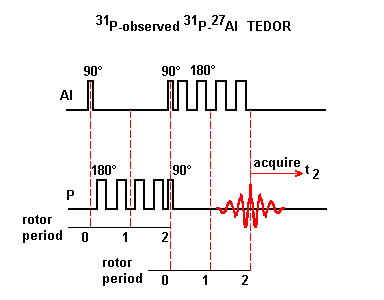Transferred-Echo DOble Resonance
Schaefer and coworkers introduced TEDOR experiment based on the heteronuclear dipole interaction for the measurement of the interatomic heteronuclear distance.
This sequence avoids the background signals from uncoupled nuclei, observed in REDOR experiment. The spectrum acquired with a TEDOR sequence shows only resonances of dipole coupled nuclei.

Various TEDOR pulse sequences are described in the literature. They involve two periods of dipole dephasing. The sequence developed by Schaefer and coworkers is the following:
(i) The initial selective 90° pulse applied to 27Al nuclei is followed by two 180° pulses per rotor period applied to 31P nuclei. After n rotor periods, coherence transfer is achieved by simultaneous application of 90° pulses to both nuclei. The TEDOR experiment involves coherence transfer of INEPT type (two pulses of the same duration).
(ii) After m rotor periods where two selective 180° pulses per rotor period are applied to the 27Al nuclei, the signal of the 31P nuclei is acquired.
The dephasing 180° pulses are applied on the observed spins before the coherence transfer, and on the unobserved nuclei after. These 180° pulses are applied at 1/4 and 3/4 of the rotor period. Without these 180° pulses, the heteronuclear dipole interaction is averaged to zero over each complete rotor period.
A series of experiments are performed with n held constant and m varied or vice versa. To extract the heteronuclear dipole coupling and interatomic distance, the echo amplitude is plotted as a function of preparation and refocusing times. A Fourier transform of this echo amplitude curve yields a spectrum.
